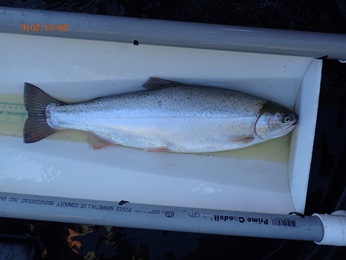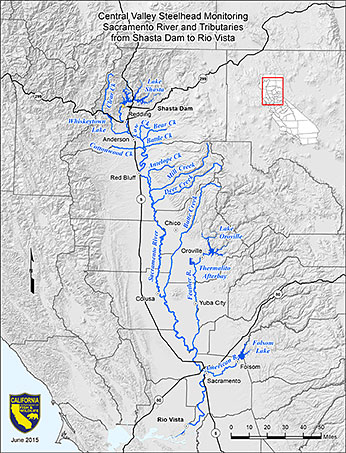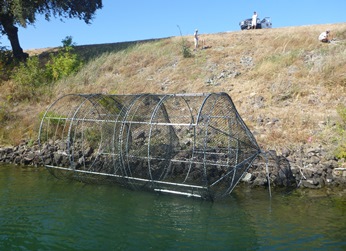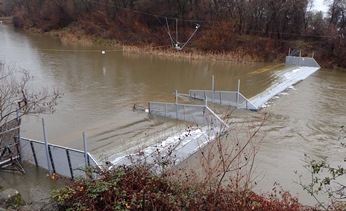(Sacramento River and tributaries, Shasta, Tehama, Butte, Sutter, Placer, Yolo, Sacramento, and San Joaquin counties)
Species / Location
 Female CV Hatchery Origin Steelhead Trout. CDFW photo.
Female CV Hatchery Origin Steelhead Trout. CDFW photo.
 Central Valley Steelhead Monitoring Map. (click/tap to enlarge)
Central Valley Steelhead Monitoring Map. (click/tap to enlarge)
California Central Valley (CV) anadromous rainbow trout (Oncorhynchus mykiss), also known as steelhead, are federally listed as threatened under the federal Endangered Species Act. The CV steelhead Distinct Population Segment (DPS) includes all naturally spawned CV steelhead populations in the Sacramento and San Joaquin rivers and their tributaries, and also includes the Coleman National Fish Hatchery and the Feather River Fish Hatchery populations. Through this listing, the federal government requires estimates on population status and trends to assist in recovery activities. Current CV steelhead monitoring is very limited, not standardized, and lacks dedicated funding. Many existing monitoring programs in the Central Valley focus on Chinook Salmon (O. tshawytscha) primarily because of their commercial importance and mitigation requirements. However, differences in life history strategies make Chinook Salmon monitoring programs inadequate for monitoring CV steelhead. CV steelhead differ from Chinook Salmon in migration timing, spawning timing, spawning requirements, and reproductive strategies.
With the onset of extreme drought conditions in 2014, the lack of basin-wide monitoring for CV steelhead impaired the Department’s ability to assess impacts to the population. Monitoring is a key component to assess the status of CV steelhead populations and it is a critical tool to evaluate the success of habitat restoration activities. This program directly responds to the Governor’s Drought Proclamation issued April 25th, 2014 directing CDFW to implement projects that respond to drought conditions through habitat restoration for the benefit of fish and wildlife impacted by the drought. This pilot project is focused on monitoring adult CV steelhead populations in the Sacramento River and tributaries.
Need for Program
In 2010, a multi-agency team developed A Comprehensive Monitoring Plan for Steelhead in the California Central Valley (Eilers et al. 2010). The plan identifies actions needed to fill knowledge gaps and collect baseline information on steelhead abundance and distribution. The goal of this plan is to provide detailed scientific procedures to measure life-cycle parameters of adult Central Valley anadromous steelhead and collect precise statistically-valid data to guide resource management, while minimizing monitoring efforts and impacts. Data collected from this project will provide Sacramento River basin-wide estimates of adult wild and hatchery steelhead population abundance, steelhead abundance estimates for select rivers and spatial distribution of steelhead in the Central Valley. In addition, these data will improve management of the threatened Central Valley steelhead populations during periods of extreme climate conditions in both the near- and long-term.
Monitoring and Research
The Central Valley Steelhead Monitoring Program (CVSMP), a pilot study, began implementing monitoring projects on the Sacramento River and select tributaries to help identify CV steelhead populations. The CVSMP projects include 1) Mainstem Sacramento River Mark-Recapture, 2) Upper Sacramento River Tributary Escapement Monitoring, 3) Sacramento River Tributary Mark-Recapture Monitoring, and 4) Hatchery Broodstock and Angler Harvest Sampling. These projects began July 2015 under contract with Pacific States Marine Fisheries Commission (PSMFC) and will continue through March 2017. The objective of the CVSMP pilot study is to evaluate the efficacy and success of these monitoring projects in order to expand these techniques throughout the Sacramento and San Joaquin watersheds.
Mainstem Sacramento River Mark-Recapture Project
The adult mark-recapture project is using large-wire fyke traps in the main stem Sacramento River to establish Sacramento River basin wide population estimates for wild and hatchery origin CV steelhead. Seven large-wire fyke traps are operated seven days a week between the American River confluence downstream to the town of Clarksburg (Figure 1). Large-wire fyke traps are operated annually from August through May when water temperatures are ≤ 72 °F. Captured adult CV steelhead are sampled for origin, sex, fork length, scales, genetics, and assessed for marks and tags. Hatchery origin individuals receive a Passive Integrated Transponder (PIT )tag and Floy tag, while natural origin individuals receive only a PIT tag. A randomly selected subsample of the hatchery origin individuals will also receive an acoustic tag. All sampled individuals are transported by boat downstream of the lower most trap for release once they have fully recovered from sampling and tagging. During the first year (2015), 49 CV steelhead were captured, marked, and released; three natural origin and 46 hatchery origin. Five of the 46 hatchery origin adult CV steelhead captured received an acoustic tag. Preliminary detection data showed all five individuals continued upstream migration, entering the American River within three to five days after release. Incidentals or bycatch are also caught in the trap along with intended species. Bycatch included two green sturgeon, six white sturgeon, 112 Chinook salmon, 6034 striped bass, and 19 other fish species (Table 1).
 Figure 1: Large-wire fyke trap. CDFW photo.
Figure 1: Large-wire fyke trap. CDFW photo.
Table 1: Bycatch totals for large-wire fyke trapping efforts, Sacramento River 2015-2016
| Fish Species
|
Totals
|
Fish Species
|
Totals
|
| CV Steelhead Trout
|
49
|
Hardhead
|
6
|
| Chinook Salmon
|
125
|
Largemouth Bass
|
4
|
| Green Sturgeon
|
2
|
Redear Sunfish
|
584
|
| White Sturgeon
|
6
|
Sacramento Blackfish
|
11
|
| Striped Bass
|
6034
|
Sacramento Hitch
|
13
|
| American Shad
|
182
|
Sacramento Pikeminnow
|
181
|
| Black Crappie
|
21
|
Sacramento Splittail
|
419
|
| Bluegill
|
6
|
Sacramento Sucker
|
111
|
| Brown Bullhead
|
4
|
Smallmouth Bass
|
284
|
| Carp
|
49
|
Spotted Bass
|
233
|
| Channel Catfish
|
13
|
White Catfish
|
61
|
| Goldfish
|
15
|
White Crappie
|
6
|
| Fish Species Total
|
-
|
|
8419
|
Upper Sacramento River Tributary Escapement Monitoring
Electronic counting stations (video and sonar cameras) were installed on select Sacramento River tributaries to estimate tributary specific escapement of adult CV steelhead. Resistance board weirs were manufactured, installed and operated on Clear and Bear Creeks from September 2015 through May 2016 (Figure 2).Video and sonar units were deployed at both resistance board weir sites. Additional resistance board weirs are being manufactured to install on selected tributaries that meet monitoring criteria.
 Figure 2: Resistance board weir equipped with video and sonar monitoring station on Clear Creek. CDFW photo.
Figure 2: Resistance board weir equipped with video and sonar monitoring station on Clear Creek. CDFW photo.
Sacramento River Tributary Mark-Recapture Monitoring
PIT tag antenna arrays will be placed within select Sacramento River tributaries. These PIT tag arrays will be implemented as a secondary mark and recapture project which will utilize the detection of PIT tags placed in adult CV steelhead captured and tagged in the Mainstem Sacramento River Mark-Recapture fyke trapping effort (described above). Detection information from these arrays will provide tributary distribution and timing data for adult CV steelhead tagged at the mainstem fyke traps. This information will be used to evaluate and enhance monitoring, research, and management goals and objectives. PIT tag antenna arrays are being manufactured for installation in the Fall of 2016 on select tributaries. Tributaries being evaluated for PIT tag antenna array installation include Clear, Battle, Mill creeks, and the Yuba River. For long-term monitoring, PIT tag antenna arrays will be constructed for several CV steelhead-bearing Sacramento River tributaries.
Hatchery Broodstock and Angler Harvest Sampling
The Feather River Hatchery (FRH) and Nimbus Fish Hatchery (NFH) are being structurally and technically evaluated for PIT tag antenna array installation. PIT tag antenna arrays in hatcheries can estimate the recapture rate of adult hatchery CV steelhead tagged during mainstem fyke trapping efforts. During spawning operations at CV steelhead hatcheries, staff identify secondary marks (Floy tags, caudal fin hole punch) and scan broodstock with hand-held PIT tag scanners. Two CV steelhead tagged in the fyke trapping effort were recaptured at NFH in 2016. In the first season, CDFWs Angler Survey Program assisted by scanning angler harvested hatchery CV steelhead with hand-held PIT tag scanners and looked for secondary marks on the Sacramento River and scheduled tributaries. Four CV steelhead capture in the mainstem fyke traps and PIT tagged were recaptured by anglers in the American River in 2016. Recapture data from the hatchery broodstock and angler harvest sampling efforts enables estimation of distribution, survival and tag retention rates.
Future Efforts
The goal of the Central Valley Steelhead Monitoring Program is to establish the foundation for long-term CV steelhead population monitoring in the California Central Valley watersheds. If monitoring techniques from this 2-year pilot study provide efficient results, the goal will establish monitoring efforts in all CV steelhead occupied tributaries of the Sacramento River watershed and expand into the San Joaquin River and tributaries. Monitoring focus will broaden to include both adult and juvenile life cycles and will incorporate additional techniques to target specific life stages.
References
For additional information, contact Jonathan Nelson, CDFW Fisheries Branch, Jonathan.Nelson@wildlife.ca.gov.